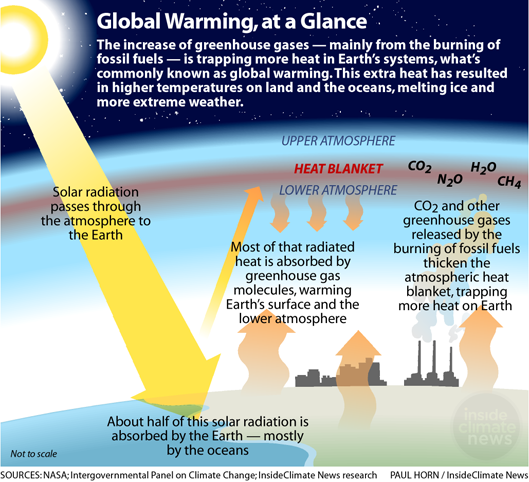Above Photo: Hurricane forecasters look closely at ocean temperatures. Sea surface temperatures above 78 degrees, shown here in yellow, orange and red, are sufficiently warm to fuel hurricanes. Credit: NOAA
Google is blocking our site. Please use the social media sharing buttons (upper left) to share this on your social media and help us breakthrough.
The oceans hold the story of a planet warming as fossil fuels are burned. Here is what scientists have discovered, in four charts.
Earth’s temperature is rising, and it isn’t just in the air around us. More than 90 percent of the excess heat trapped by greenhouse gas emissions has been absorbed into the oceans that cover two-thirds of the planet’s surface. Their temperature is rising, too, and it tells a story of how humans are changing the planet.
This accrued heat is “really the memory of past climate change,” said Kevin Trenberth, the head of climate analysis at the National Center for Atmospheric Research and co-author of a new paper on ocean warming.
It’s not just the amount of warming that is significant—it’s also the pace.
The rate at which the oceans are heating up has nearly doubled since 1992, and that heat is reaching ever deeper waters, according to a recent study. At the same time, concentrations of carbon dioxide in the atmosphere have been rising.
The charts that follow show how the oceans are changing and what they’re telling us as a thermometer of global warming.
 Scientists say the accumulation of heat in the oceans is the strongest evidence of how fast Earth is warming due to heat-trapping gases released by the burning of fossil fuels.
Scientists say the accumulation of heat in the oceans is the strongest evidence of how fast Earth is warming due to heat-trapping gases released by the burning of fossil fuels.
Oceans have enormous capacity to hold heat. So ocean temperatures, unlike temperatures on land, are slow to fluctuate from natural forces, such as El Niño/La Niña patterns or volcanic eruptions. Think night and day, said Trenberth. As night falls on land, so do air temperatures. But in the oceans, temperatures vary little.
This makes it easier to tease out the influence of human-caused climate change from other possible causes of surging ocean heat.
 How much extra heat are we talking about? And what are the impacts on the climate system? “On a day-to-day a basis, it’s really quite small,” Trenberth said, but the cumulative effects are not.
How much extra heat are we talking about? And what are the impacts on the climate system? “On a day-to-day a basis, it’s really quite small,” Trenberth said, but the cumulative effects are not.
According to research by Trenberth and Lijing Cheng, of the Institute for Atmospheric Physics in Beijing, the heat storage in the oceans during 2015 and 2016 amounted to a stunning force: an increase of 30.4 X 1022 joules of energy roiling Earth’s systems since 1960. The overload is helping throw off Earth’s energy balance, needed for the climate to be relatively stable. Put another way: The excess energy amassed in the oceans since 1992 is roughly equivalent to 2,000 times U.S. electricity generation during the past decade, the researchers explained.
Ocean temperatures have been rising about 0.12 degrees Celsius per decade on average over the past 50 years. The higher temperatures are driving marine life toward the poles in search of livable habitats, bleaching coral reefs, and causing severe impacts on fisheries and aquacultures. They also contribute to more frequent and intense extreme weather events. In the three back-to-back deadly hurricanes of 2017—Harvey, Irma and Maria—warmer waters played a role in worsening the storms.
 Though ocean temperature represents a clear signal of climate change, one challenge for researchers is that the record only goes back so far. Since the early 2000s, an international effort called Argo has launched nearly 4,000 ocean-going sensors that gather important data about the oceans, including temperature.
Though ocean temperature represents a clear signal of climate change, one challenge for researchers is that the record only goes back so far. Since the early 2000s, an international effort called Argo has launched nearly 4,000 ocean-going sensors that gather important data about the oceans, including temperature.
Meanwhile, as oceans heat up, thermal expansion causes sea levels that are already rising from the melting of land ice (triggered by higher air and sea temperatures) to rise even more. Nearly 50 percent of the sea level rise so far has come from ocean warming, according to new work by Cheng and Trenberth. Much of the rest comes from the melting of ice on Antarctica and Greenland.
 Ocean warming can impact sea level rise in another way, too. This year has seen extensive losses from Antarctica’s ice shelves. “It’s most likely because that ice is being undermined through warmer ocean underneath the ice, which is contributing to the thinning of the ice and weakening of the shelf,” Trenberth said. The ice shelves themselves are already floating, but they are attached to land and play a critical role in slowing the ocean-bound ice flow from the massive ice sheets behind them. Scientists say the West Antarctic Ice Sheet alone holds enough ice to raise global sea level by about 11 feet.
Ocean warming can impact sea level rise in another way, too. This year has seen extensive losses from Antarctica’s ice shelves. “It’s most likely because that ice is being undermined through warmer ocean underneath the ice, which is contributing to the thinning of the ice and weakening of the shelf,” Trenberth said. The ice shelves themselves are already floating, but they are attached to land and play a critical role in slowing the ocean-bound ice flow from the massive ice sheets behind them. Scientists say the West Antarctic Ice Sheet alone holds enough ice to raise global sea level by about 11 feet.

